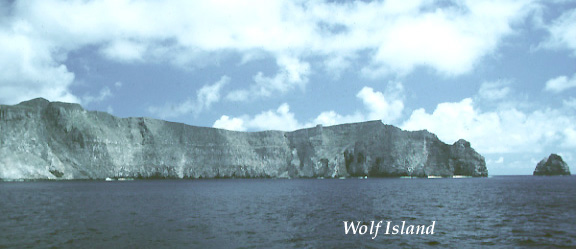|
Description of the Galapagos Islands Isla Wolf and Isla Darwin  | | Darwin Island and the cliffs of Wolf Island. Picture source: http://www.geo.cornell.edu/geology/GalapagosWWW/WolfDarwin.html |
Wolf and Darwin Islands, also known as Wenman and Culpepper respectively, are two eroded volcanos located on a volcanic ridge (the Wolf-Darwin Lineament) aligned northwest-southeast. The ridge extends from the northwest part of the Galapagos Platform to the Galapagos Spreading Center, some 150 km to the north. Though Wolf reaches a maximum elevation of only 250 m and Darwin only 165 m above sea level, the islands are only the tips of much larger volcanos that rise more than 1000 m above the sea floor. Both volcanos are now extinct; potassium-argon ages of Darwin show it to be 400,000 years old, while ages of lavas from Wolf range from 900,000 to 1,600,000 years. There are several smaller volcanos located along the Wolf-Darwin lineament that do not reach the sea surface. Potassium-argon ages from some of these seamounts are as young as 30,000 years and these volcanos are probably still active.
The origin of the Wolf-Darwin Lineament remains somewhat enigmatic. One hypothesis is that it reflects channeled flow of material from the Galapagos mantle plume to the Galapagos Spreading Center within the uppermost mantle. Another hypothesis is that is a fault or tear in the lithosphere that allows magma to rise to the surface.
These two small islets are inhabited only by sea birds and are rarely visited. The relatively quite waters in the bay formed by Wolf's caldera is, however, a wonderful place for snorkelling and scuba diving.
|







